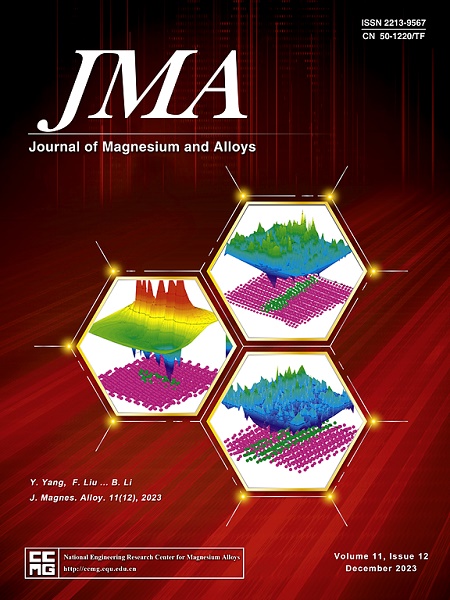Enhancing the photocatalytic performance and chemical durability of AZ31 magnesium alloy by incorporating two types of nanoparticles through plasma electrolytic oxidation
IF 15.8
1区 材料科学
Q1 METALLURGY & METALLURGICAL ENGINEERING
引用次数: 0
Abstract
The difficulty in achieving a balance between photocatalytic efficiency and chemical robustness has been a barrier to the broad use of MgO as a versatile material, mainly because of its restricted surface activity. To overcome this, a novel surface modification technique is proposed. It involves the integration of highly stable SnO and WO nanoparticles, which are known to enhance surface activity. This approach aims to achieve an optimal balance between efficiency and stability by finely tuning the structure-surface reactivity relationship. The technique utilizes a plasma electrolytic oxidation (PEO) method. In this method, both the AZ31 Mg alloy substrate and SnO/WO precursors undergo simultaneous oxidation. This is induced by high-energy plasma generated through high voltage. The results demonstrate that this process yields a MgO layer with a homogeneous dispersion of SnO and WO nanoparticles, significantly enhancing its overall performance. Corrosion measurements demonstrated enhanced electrochemical stability against chloride ions. The dual incorporation resulted in a hybrid film exhibiting a corrosion current density value of 7.57 × 10 A/cm and a high outer layer resistance of 5.17 × 10 Ω.cm. Additionally, the dual incorporation of SnO and WO nanoparticles enhances the photocatalytic activity of AZ31 Mg towards tetracycline degradation. This results in a photocatalytic efficiency of 89.54 % within 2 h of exposure to visible light using the BA-W-Sn sample, which outperforms other samples. This integrated strategy enables the study to contribute significantly to expanding the practical applications of MgO-based materials. It does so by simultaneously enhancing their photocatalytic activity and chemical stability.通过等离子电解氧化法加入两种纳米粒子提高 AZ31 镁合金的光催化性能和化学耐久性
要在光催化效率和化学稳健性之间取得平衡十分困难,这一直是氧化镁作为一种多功能材料得到广泛应用的障碍,主要原因是其表面活性受到限制。为了克服这一问题,我们提出了一种新型表面改性技术。该技术涉及高度稳定的氧化锡和氧化钨纳米颗粒的整合,众所周知,这两种物质可增强表面活性。这种方法旨在通过微调结构-表面反应活性关系,实现效率和稳定性之间的最佳平衡。该技术采用等离子电解氧化(PEO)方法。在这种方法中,AZ31 镁合金基底和氧化锡/氧化钨前驱体同时发生氧化。这是由高压产生的高能等离子体引起的。结果表明,这一过程产生的氧化镁层具有均匀分散的氧化锡和氧化钨纳米颗粒,显著提高了其整体性能。腐蚀测量结果表明,对氯离子的电化学稳定性增强。双重掺杂使混合薄膜的腐蚀电流密度值达到 7.57 × 10 A/cm,外层电阻高达 5.17 × 10 Ω.cm。此外,氧化锡和 WO 纳米粒子的双重加入增强了 AZ31 Mg 降解四环素的光催化活性。这使得 BA-W-Sn 样品在可见光下暴露 2 小时内的光催化效率达到 89.54%,优于其他样品。这种综合策略使这项研究能够为扩大氧化镁基材料的实际应用范围做出重大贡献。它同时提高了氧化镁材料的光催化活性和化学稳定性。
本文章由计算机程序翻译,如有差异,请以英文原文为准。
求助全文
约1分钟内获得全文
求助全文
来源期刊

Journal of Magnesium and Alloys
Engineering-Mechanics of Materials
CiteScore
20.20
自引率
14.80%
发文量
52
审稿时长
59 days
期刊介绍:
The Journal of Magnesium and Alloys serves as a global platform for both theoretical and experimental studies in magnesium science and engineering. It welcomes submissions investigating various scientific and engineering factors impacting the metallurgy, processing, microstructure, properties, and applications of magnesium and alloys. The journal covers all aspects of magnesium and alloy research, including raw materials, alloy casting, extrusion and deformation, corrosion and surface treatment, joining and machining, simulation and modeling, microstructure evolution and mechanical properties, new alloy development, magnesium-based composites, bio-materials and energy materials, applications, and recycling.
 求助内容:
求助内容: 应助结果提醒方式:
应助结果提醒方式:


